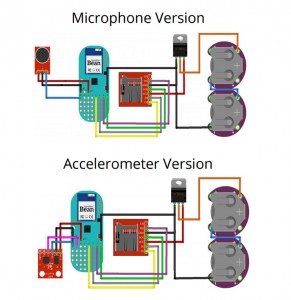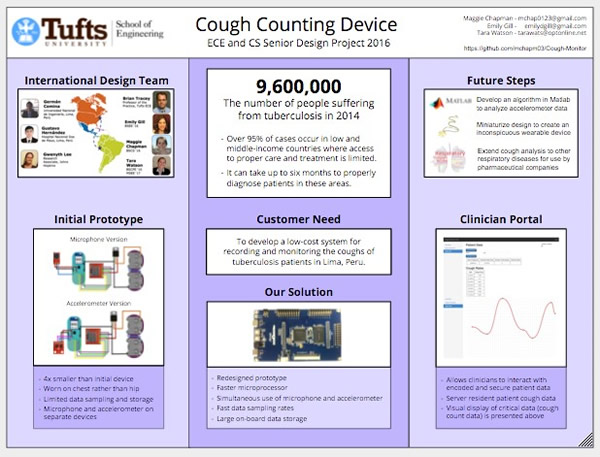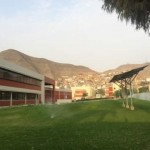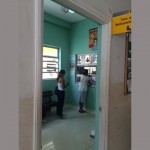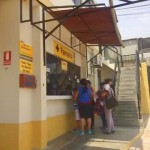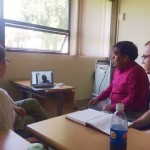Purple Team 2016
Emily Gill, Tara Watson with Maggie Chapman (Computer Science)
Automated Cough Counting System
In 2014, 9.6 million people suffered from tuberculosis (TB), and 1.5 million people died from the disease. Over 95% of cases occur in low and middle-income countries, where access to proper diagnosis and treatment is limited. Standard drugs have been used for decades, and resistance to the medicines is widespread. Disease strains that are resistant to at least one drug have been documented in every country surveyed by the World Health Organization. Serious epidemics of drug-resistant TB jeopardize TB control in several countries, including Peru. In areas without laboratory access, diagnosis of multi-drug resistant tuberculosis (MDR-TB) occurs after patients fail to respond to basic TB treatment for 4-6 months. During this time, patients remain infectious and there is an increased rate of fatality.
A need exists for a low-cost, lab-free method for MDR-TB diagnosis. Our clinical research has shown that the cough rate of patients responding to basic TB treatment decreases by roughly 50% within the first 2-6 weeks. Based on this research, we have designed a cough monitoring device and software application. Patients will receive the device from a healthcare provider a few times during the initial treatment phase, and they will wear the device for periods of 4 hours. We have designed it such that they can wear it at home with minimal change to their normal activity. After the initial treatment phase, if patients do not show a positive response, they will begin to receive treatment for the multi-drug resistant strain. In March 2016, our team brought the original prototype to Peru (see below). We received feedback on the functionality and design of the device from Peruvian doctors, nurses, and engineers. After the team returned, we developed a second prototype to address the concerns brought up by the Peruvian Team. We also discussed using the device to help treat other respiratory diseases.
Related Tech Notes
- Measuring Tuberculosis Treatment Response: Cough Detection (pdf) by Emily Gill
- Measuring Tuberculosis Treatment Response: Cough Analysis and Presentation (pdf) by Tara Watson
Purple Team Project Poster
Purple Team Peruvian Trip
These pictures are from the Purple Team’s trip to Lima, Peru in March/April of 2016. They show the hospitals where the device will be implemented, the local communities, and the major engineering university of Lima, Universidad Nacional de Ingeniería (UNI).
- Senior Capstone Projects Summary for the 2015-16 Academic Year > Purple Team 2016
Search the Handbook:
Handbook Overview
- Introduction and Acknowledgements
- Senior Capstone Projects Summary for the 2022-23 Academic Year
- Senior Capstone Projects Summary for the 2021-22 Academic Year
- Senior Capstone Projects Summary for the 2020-21 Academic Year
- Senior Capstone Projects Summary for the 2019-20 Academic Year
- Senior Capstone Projects Summary for the 2018-19 Academic Year
- Senior Capstone Projects Summary for the 2017-18 Academic Year
- Senior Capstone Projects Summary for the 2016-17 Academic Year
- Senior Capstone Projects Summary for the 2015-16 Academic Year
- Senior Capstone Projects Summary for the 2014-15 Academic Year
- Senior Capstone Projects Summary for the 2013-14 Academic Year
- Senior Capstone Projects Summary for the 2012-13 Academic Year
- 1. Design Process
- 2. Management
- 3. Technologies
- 4. Communications And Life Skills
- 5. Tech Notes
Top Topics
Apple iPhone Assistive Technologies Big Data Bridge Inspection Business Strategy Communications Computer Vision Consumer Technologies Cough detection Creativity & Innovation Data Analysis Design for X Emergency resource management Emerging Technologies Encryption Engineering Economics Ethics GPS Indoor Navigation Industrial Technologies Internet of Things Interpersonal Skills Legal & Intellectual Property Marketing & Customer Research Mobile Applications OpenCV Product Development Life Cycle Product Liability Prototyping & Manufacturing Recommender System Remote Keyless Entry Risk Risk Management Security Sensors Signal Processing Societal Impact Synthetic Aperture Radar Tuberculosis UAV Drones UAV Motion Unmanned Technologies Virtual Reality Visual Impairment Wireless

